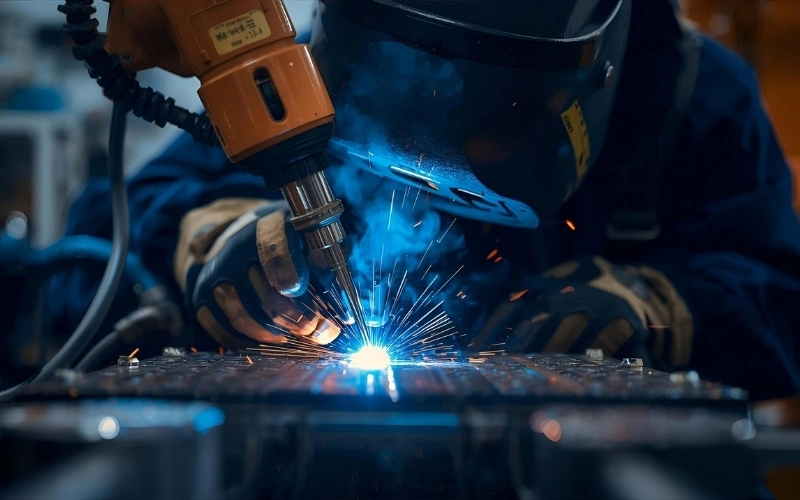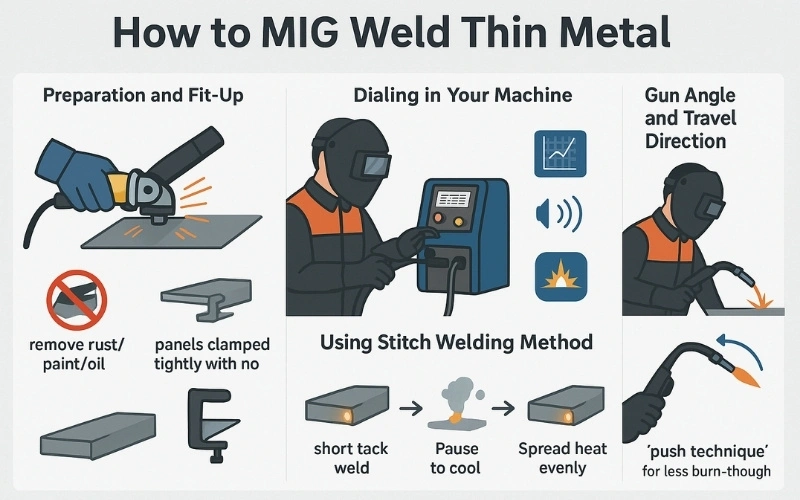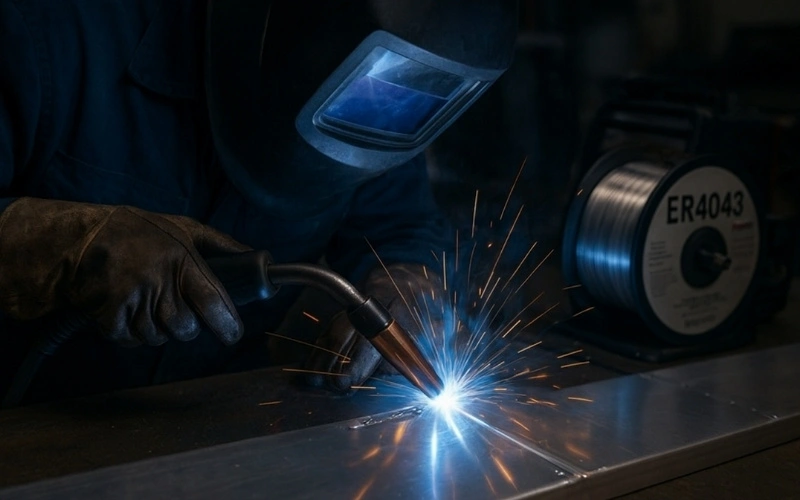Metal Inert Gas (MIG) welding is one of the most popular methods in welding sheet metal, known for its speed, versatility, and ease of learning. Whether you are a beginner or a professional, understanding MIG welding is really important. In this comprehensive guide, we will explore what MIG welding is, how it works, its advantages and challenges, and practical tips to help you achieve strong, clean welds.
What is MIG Welding?
MIG welding, or Gas Metal Arc Welding (GMAW), is an arc welding process that uses a wire electrode fed through a welding gun. The electric arc melts the wire to form a weld pool, protected by shielding gases like argon or carbon dioxide. This method is valued for its speed, versatility, and ease of learning. It is widely used in automotive, construction, and metal fabrication. Common issues include spatter, porosity, and higher equipment costs, which require good setup, technique, and safety practices.

How to MIG Weld Thin Metal?
The process of MIG welding has 4 main steps, including:
Preparation and Fit-Up
On thick metal, you can sometimes get away with less-than-perfect prep. On thin metal, it’s non-negotiable.
- Cleanliness: Grind the weld area down to clean, shiny metal. Make sure to remove all paint, rust, primer, and oil before welding.
- Gaps: Your panels should fit tightly with no space between them. Gaps are the primary cause of burn-through because they force the arc to stretch, creating excessive heat and preventing a steady weld puddle. Always clamp the panels securely so they sit flush together.
Dialing in Your Machine
Before you touch your actual project, always test on a piece of scrap metal of the same thickness.
- Start with the chart: Most welders include a settings chart inside the wire feed compartment. Use this as a guide for setting voltage and wire feed speed based on your material thickness and wire size.
- Fine-tune by sound and sight: A properly adjusted MIG welder produces a steady, crackling sound (similar to frying bacon). If the weld bead looks tall and uneven (“cold”), try increasing the voltage slightly or lowering the wire feed speed. If the arc spits and pushes the gun back, your voltage is likely too high.
Using Stitch Welding Method
This is the most effective way to prevent burn-through and warping. Avoid running one long, continuous bead. Instead, build the seam with short, separate welds.
- Make a small tack: Begin with a short tack weld, about 1/2 inch long. Pull the trigger, form a small puddle, then release.
- Stop and cool: Pause after each tack. Let it cool for a few seconds to control the heat.
- Jump to a new spot: Move a few inches away and make another short weld.
- Spread the heat: Keep repeating this process, spacing your welds along the seam. This spreads heat evenly instead of focusing it in one spot, which prevents warping.
- Connect the dots: Once the seam is held together with tacks, go back and fill the gaps using the same short stitch method. This gives you a solid, strong seam with less heat buildup.
Gun Angle and Travel Direction (Push Technique)
For thin materials, the “push” technique is generally preferred. This means you angle the gun slightly and push it away from the finished weld bead. This technique tends to create a slightly less penetrative, flatter, and wider bead, which helps spread the heat and further reduces the risk of burn-through.

Important Equipment for MIG Welding
Your success in welding thin metal starts with the right setup. While the basic components are the same for any MIG job, there are specific considerations for working with delicate materials.
Welding Machine (Power Source)
This is the heart of your setup. It supplies the power and drives the wire feeder. For thin sheet metal, control matters more than raw power. Smaller 120V welders, often referred to as hobby or DIY machines, work very well because they operate at the lower amperage required to prevent burn-through.
MIG Gun
This is the handheld tool you use to direct the wire and gas. When you pull the trigger, the wire feeds, the gas flows, and the machine provides power. A lightweight, comfortable gun makes it easier to stay steady and maintain control on thin panels.
Shielding Gas
For thin steel sheet metal, the standard gas is C25 (a mix of 75% Argon and 25% CO2). This blend gives smooth arc control, steady puddle flow, and minimal spatter, which is ideal for clean work like auto body repairs.
Ground Clamp
The ground clamp completes the electrical circuit. Attach it to a clean, bare metal surface. Poor ground leads to an unstable arc and uneven heat, which can ruin thin metal quickly.
Consumables (The Wire)
This is one of the most critical factors for welding thin metal. You must use a small-diameter wire. The most common sizes are 0.023 or 0.024 inch (0.6mm). A thinner wire requires less energy to melt, which gives you significantly more control over your heat input. Using thicker wire, such as 0.030 or 0.035 inch, dumps too much heat and material, making it nearly impossible to weld thin panels without causing damage.
Common Mistakes When MIG Welding Thin Metal
Learning to troubleshoot is a huge part of welding. Here are the most common issues you’ll face with thin metal and how to solve them.
Burn-through
- Cause: Too much heat. This happens if your settings are too high, you move too slowly, or you try to run a long, continuous bead.
- Solution: Lower the voltage, increase your travel speed, and use the stitch welding method to control heat.
Warping
- Cause: Heat builds up in one area for too long, causing the metal to expand and bend.
- Solution: Use the stitch welding method and spread your welds evenly along the seam to maintain even heat distribution. Always clamp your workpiece firmly to a flat surface to reduce distortion.
“Bird Dropping” Welds
- Cause: The bead looks tall, rounded, and not properly fused. This usually occurs when the wire feed speed is too fast for the voltage, or when the gun is moved too quickly for a puddle to form.
- Solution: Reduce the wire feed speed or slightly raise the voltage. Slow your travel speed just enough to let a proper puddle form and flow smoothly into the base metal.
Settings and Parameters for Thin Metal
These settings are practical starting points for short-arc MIG welding in a draft-free environment. Always test on a piece of scrap from your project before welding the actual workpiece. Use a push angle of 10-15°, a contact-tip-to-work distance (CTWD) of 6-10 mm, and avoid wide weaving – keep motion minimal on thin sheets to prevent distortion.
Steel (24-16 Gauge)
We recommend using the ER70S-6 wire (0.023 inch).
| Gauge (approx. mm) | Voltage (V) | WFS (ipm) | Technique Notes |
| 24 ga (0.6 mm) | 16.0-16.5 | 180-220 | 0.5s trigger stitches; use copper backing to absorb heat |
| 22 ga (0.8 mm) | 16.5-17.5 | 220-260 | Short stitches; “connect-the-dots” technique; skip around joints |
| 20 ga (0.9 mm) | 17.0-18.0 | 260-300 | Slightly longer stitches possible; watch for panel distortion |
| 18 ga (1.2 mm) | 17.5-18.5 | 300-340 | Short continuous runs are possible; keep weave minimal |
| 16 ga (1.6 mm) | 18.0-19.0 | 340-380 | Stringer beads 20-40 mm long; stagger welds to distribute heat |
Key Tips:
- Start at the low end of the voltage range and adjust upward only if necessary.
- Keep welds short and intermittent on thin sheets to avoid warping.
- Copper backing bars help absorb excess heat and reduce burn-through.
Stainless Steel
Use ER308L (or appropriate grade). Wire: 0.023-0.030 inch (0.6-0.8 mm). Gas: Argon with 1-2% CO2 or O2, or a tri-mix for short-arc.
| Thickness | Voltage (V) | WFS (ipm) / Wire | Notes |
| 0.8-1.0 mm (22-20 ga) | 16.5-17.5 | 180-240 / (0.023 inch) | Keep heat input low; minimize heat tint; back purge roots where needed |
| 1.2 mm (18 ga) | 17.5-18.5 | 220-280 / (0.023-0.030 inch) | Use short stitches; immediate post-clean if corrosion resistance is critical |
Tip: Reduce reactive gases (CO2, O2) to preserve corrosion resistance. For food-grade or chemical environments, control the heat tint carefully.
Aluminum
Use ER4043 wire (0.030-0.035 inch). Gas: 100% Argon. Spool gun or push-pull gun recommended. Always use the push technique.
| Thickness | Mode | Voltage/Program | WFS/Trim | Notes |
| 1.0-1.5 mm | Pulsed | Select 4043/Ar program | Adjust trim per OEM (+/- 0.1-0.3mm) | Use stitch or short beads; fast travel; maintain cleanliness |
| 1.5-2.0 mm | Pulsed or smooth short spray (if available) | Select 4043/Ar program | Adjust trim per OEM (+/- 0.1-0.3mm) | Copper backing helps on edges; allow cooling between welds |
Tip: Without pulsed, aluminum thin‑gauge MIG is unforgiving. If your machine doesn’t support pulsed MIG, practice extensively on scrap and consider TIG welding for critical applications.

Why is MIG the Best Choice for Thin Metal?
When we compare MIG welding to TIG or stick welding, it remains the best choice for thin materials, especially for beginners. Here is a quick comparison to explain why.
| MIG welding | TIG welding | Stick welding | |
| Heat control | Excellent. Wire speed and voltage are easily adjustable for precise, low heat input | Excellent, but much slower, and requires significantly more skill to manage | Poor. It’s very difficult to control heat input, making it extremely prone to burn-through on thin metal |
| Speed | Fast. The point-and-shoot nature is highly efficient for stitching panels together | Very slow. The process is meticulous and time-consuming | Slow, with constant stops to change rods |
| Ease of use | Easiest. The simple operation makes it perfect for beginners tackling sheet metal | Very Difficult. Requires two-handed coordination and often a foot pedal | Difficult on thin material; not recommended |
| Result | Produces clean welds that require only light grinding or finishing | Creates perfect, beautiful welds, but takes significant time and skill | Leaves behind messy welds covered in slag; not suitable for auto body or cosmetic work |
Read more: What is stick welding and how is it applied?
Conclusion
MIG welding is a versatile and accessible process, and with proper settings and technique, it works well for thin metals like steel, stainless steel, and aluminum. By controlling voltage, wire speed, and travel while applying methods such as stitch welding, short beads, or copper backing, you can avoid burn-through and warping and create clean, strong welds. Whether for automotive repair, sheet metal fabrication, or DIY work, mastering MIG welding on thin materials builds both skill and confidence. Start practicing today on scrap metal and refine your settings until you achieve consistent, high-quality results.
FAQs
The absolute best choice is 0.6mm solid wire. This small diameter is the key to controlling heat and preventing burn-through on thin automotive panels (typically 18-22 gauge).
Always follow your welder’s settings chart. For 22-gauge steel with 0.023-inch wire, use low voltage and wire speed. Test and adjust on scrap before welding your project.
